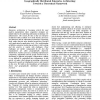Free Online Productivity Tools
i2Speak
i2Symbol
i2OCR
iTex2Img
iWeb2Print
iWeb2Shot
i2Type
iPdf2Split
iPdf2Merge
i2Bopomofo
i2Arabic
i2Style
i2Image
i2PDF
iLatex2Rtf
Sci2ools
HICSS
2008
IEEE
2008
IEEE
Geographically Distributed Enterprise Architecting: Towards a Theoretical Framework
Enterprise architecting is becoming critical for most modern organizations whose competitive strategies are tightly linked to the underlying information technology (IT) infrastructure. The reason for this is that an enterprise architecture takes a holistic view of the business processes and functions and the information technologies supporting them, rather than the more detailed perspectives provided with application-by-application views. Our understanding of effective enterprise architecting activities is still evolving and this practice is replete with challenges. These challenges are further compounded by the fact that organizations are often geographically dispersed. Furthermore, business processes, technology infrastructure components, information and the people involved may be distributed in different geographic configurations, making it very difficult to comprehend their organization. In this article, we make a first attempt at providing a theoretical framework to guide our thi...
Biometrics | Business Processes | Enterprise Architecting | Enterprise Architecting Activities | HICSS 2008 | System Sciences |
| Added | 29 May 2010 |
| Updated | 29 May 2010 |
| Type | Conference |
| Year | 2008 |
| Where | HICSS |
| Authors | J. Alberto Espinosa, Frank Armour |
Comments (0)

